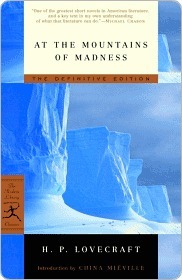More on this book
Community
Kindle Notes & Highlights
Through the desolate summits swept raging intermittent gusts of the terrible antarctic wind; whose cadences sometimes held vague suggestions of a wild and half-sentient musical piping, with notes extending over a wide range, and which for some subconscious mnemonic reason seemed to me disquieting and even dimly terrible. Something about the scene reminded me of the strange and disturbing Asian paintings of Nicholas Roerich, and of the still stranger and more disturbing descriptions of the evilly fabled plateau of Leng which occur in the dreaded Necronomicon of the mad Arab Abdul Alhazred. I
...more
“Complete specimens have such uncanny resemblance to certain creatures of primal myth that suggestion of ancient existence outside antarctic becomes inevitable. Dyer and Pabodie have read Necronomicon and seen Clark Ashton Smith’s nightmare paintings based on text, and will understand when I speak of Elder Things supposed to have created all earth-life as jest or mistake. Students have always thought conception formed from morbid imaginative treatment of very ancient tropical radiata. Also like prehistoric folklore things Wilmarth has spoken of—Cthulhu cult appendages, etc.
In the whole spectacle there was a persistent, pervasive hint of stupendous secrecy and potential revelation; as if these stark, nightmare spires marked the pylons of a frightful gateway into forbidden spheres of dream, and complex gulfs of remote time, space, and ultra-dimensionality. I could not help feeling that they were evil things—mountains of madness whose farther slopes looked out over some accursed ultimate abyss. That seething, half-luminous cloud-background held ineffable suggestions of a vague, ethereal beyondness far more than terrestrially spatial; and gave appalling reminders of
...more
It was young Danforth who drew our notice to the curious regularities of the higher mountain skyline—regularities like clinging fragments of perfect cubes, which Lake had mentioned in his messages, and which indeed justified his comparison with the dream-like suggestions of primordial temple-ruins on cloudy Asian mountain-tops so subtly and strangely painted by Roerich. There was indeed something hauntingly Roerich-like about this whole unearthly continent of mountainous mystery. I had felt it in October when we first caught sight of Victoria Land, and I felt it afresh now. I felt, too,
...more
This highlight has been truncated due to consecutive passage length restrictions.
The whole arrangement looked like the ruins of Machu Picchu in the Andes, or the primal foundation-walls of Kish as dug up by the Oxford–Field Museum Expedition in 1929; and both Danforth and I obtained that occasional impression of separate Cyclopean blocks which Lake had attributed to his flight-companion Carroll. How to account for such things in this place was frankly beyond me, and I felt queerly humbled as a geologist.
As I have said, the hypothesis of Taylor, Wegener, and Joly that all the continents are fragments of an original antarctic land mass which cracked from centrifugal force and drifted apart over a technically viscous lower surface—an hypothesis suggested by such things as the complementary outlines of Africa and South America, and the way the great mountain chains are rolled and shoved up—receives striking support from this uncanny source.
Certainly, we were in one of the strangest, weirdest, and most terrible of all the corners of earth’s globe. Of all existing lands it was infinitely the most ancient; and the conviction grew upon us that this hideous upland must indeed be the fabled nightmare plateau of Leng which even the mad author of the Necronomicon was reluctant to discuss.
Of course common reading is what prepared us both to make the interpretation, though Danforth has hinted at queer notions about unsuspected and forbidden sources to which Poe may have had access when writing his Arthur Gordon Pym a century ago. It will be remembered that in that fantastic tale there is a word of unknown but terrible and prodigious significance connected with the antarctic and screamed eternally by the gigantic, spectrally snowy birds of that malign region’s core. “Tekeli-li! Tekeli-li!” That, I may admit, is exactly what we thought we heard conveyed by that sudden sound behind
...more
It is absolutely necessary, for the peace and safety of mankind, that some of earth’s dark, dead corners and unplumbed depths be let alone; lest sleeping abnormalities wake to resurgent life, and blasphemously surviving nightmares squirm and splash out of their black lairs to newer and wider conquests.


